
Jenolan Caves
Encyclopedia
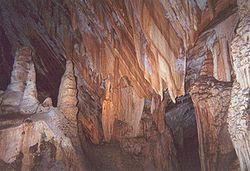
Cave
A cave or cavern is a natural underground space large enough for a human to enter. The term applies to natural cavities some part of which is in total darkness. The word cave also includes smaller spaces like rock shelters, sea caves, and grottos.Speleology is the science of exploration and study...
s in the Blue Mountains, New South Wales
New South Wales
New South Wales is a state of :Australia, located in the east of the country. It is bordered by Queensland, Victoria and South Australia to the north, south and west respectively. To the east, the state is bordered by the Tasman Sea, which forms part of the Pacific Ocean. New South Wales...
, Australia
Australia
Australia , officially the Commonwealth of Australia, is a country in the Southern Hemisphere comprising the mainland of the Australian continent, the island of Tasmania, and numerous smaller islands in the Indian and Pacific Oceans. It is the world's sixth-largest country by total area...
; 175 kilometres west of Sydney
Sydney
Sydney is the most populous city in Australia and the state capital of New South Wales. Sydney is located on Australia's south-east coast of the Tasman Sea. As of June 2010, the greater metropolitan area had an approximate population of 4.6 million people...
. They are the most celebrated of several similar groups in the limestone
Limestone
Limestone is a sedimentary rock composed largely of the minerals calcite and aragonite, which are different crystal forms of calcium carbonate . Many limestones are composed from skeletal fragments of marine organisms such as coral or foraminifera....
of the country being the oldest discovered open caves in the world. They include numerous Silurian
Silurian
The Silurian is a geologic period and system that extends from the end of the Ordovician Period, about 443.7 ± 1.5 Mya , to the beginning of the Devonian Period, about 416.0 ± 2.8 Mya . As with other geologic periods, the rock beds that define the period's start and end are well identified, but the...
marine fossil
Fossil
Fossils are the preserved remains or traces of animals , plants, and other organisms from the remote past...
s of great interest and the calcite
Calcite
Calcite is a carbonate mineral and the most stable polymorph of calcium carbonate . The other polymorphs are the minerals aragonite and vaterite. Aragonite will change to calcite at 380-470°C, and vaterite is even less stable.-Properties:...
formations, sometimes pure white, are of extraordinary beauty. The cave network is enormous - over 40 km of multi-level passages - still undergoing active exploration. Several kilometres of the caves have been rendered easily accessible to paying visitors and are well lit.
History
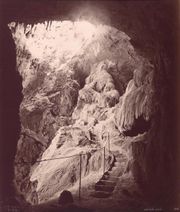
Potassium
Potassium is the chemical element with the symbol K and atomic number 19. Elemental potassium is a soft silvery-white alkali metal that oxidizes rapidly in air and is very reactive with water, generating sufficient heat to ignite the hydrogen emitted in the reaction.Potassium and sodium are...
and trapped argon
Argon
Argon is a chemical element represented by the symbol Ar. Argon has atomic number 18 and is the third element in group 18 of the periodic table . Argon is the third most common gas in the Earth's atmosphere, at 0.93%, making it more common than carbon dioxide...
gas, which was produced when the potassium decayed, scientists determined the age of the clay in the cave to be approximately 340 million years old, thereby making this cave complex the world's oldest known and dated open cave system. The Commonwealth Scientific and Industrial Research Organisation
Commonwealth Scientific and Industrial Research Organisation
The Commonwealth Scientific and Industrial Research Organisation is the national government body for scientific research in Australia...
(CSIRO) in association with the University of Sydney
University of Sydney
The University of Sydney is a public university located in Sydney, New South Wales. The main campus spreads across the suburbs of Camperdown and Darlington on the southwestern outskirts of the Sydney CBD. Founded in 1850, it is the oldest university in Australia and Oceania...
and the Australian Museum
Australian Museum
The Australian Museum is the oldest museum in Australia, with an international reputation in the fields of natural history and anthropology. It features collections of vertebrate and invertebrate zoology, as well as mineralogy, palaeontology, and anthropology...
lead the efforts in scientific research into the caves.
Local Gundungarra tribes knew Jenolan Caves area as 'Binoomea' (Dark Places) and possibly shunned them; in approximately 1835-40 the area was recorded for the first time by either James, Charles or Alf Whalan, three brothers who each claimed to have discovered the caves while searching for a bushranger
Bushranger
Bushrangers, or bush rangers, originally referred to runaway convicts in the early years of the British settlement of Australia who had the survival skills necessary to use the Australian bush as a refuge to hide from the authorities...
, James McKeown, whom they claimed used the caves as a hide-out. One of the less-visited caverns in the area is called McKeown's Hole, however there is no actual evidence of his existence. It is more likely the brothers were searching for cattle that had strayed from their nearby farm.
One theory is that the name "Jenolan" is said to come from "Genowlan", the Aboriginal name for a local mountain peak. Another theory is that is derived from the name of an early settler, J. Nolan.
The caves, then known as the Fish River Caves, came under New South Wales Government control in 1866, becoming only the second area in the world reserved for the purpose of conservation and the following year Jeremiah Wilson was appointed as the first "Keeper of the Caves". Wilson not only explored the already known Elder and Lucas Caves but later discovered the Imperial, Left Imperial (now known as Chifley), Jersey and Jubilee Caves. The caves were open to tourism early, but there was little protection from visitors damaging formations until souveniring was banned in 1872. In 1884 the name Jenolan Caves was adopted, an Aboriginal name meaning 'high place' as it is named after Mount Jenolan nearby.
The road to the caves originally went in from Tarana, which meant that travellers from the south had to take a long, roundabout route of about 90 miles from Katoomba to Oberon
Oberon, New South Wales
-See also:*Oberon Correctional Centre*Mount Trickett*Mount Bindo*Shooters Hill-External links:***...
, and, from there, to Tarana.
In the mid-1880s, hotel keepers in Katoomba wanted to improve business by constructing a road to the Caves from their town, but the steep, rough ground between the caves and town was a major obstacle, and several attempts failed. However, representations were made to the state premier by Peter Fitzpatrick of Burragorang, who was connected to some mining operations near Katoomba.
In April, 1884, William Marshall Cooper, Surveyor of Public Parks for the State Government, was assigned the job, and worked out a horse-and-carriage track in a 10-day trek from Katoomba to the Caves. The route was, he remarked, 26.5 miles from the Western Hotel in Katoomba. "... Anyone accustomed to walking can do it comfortably in 12 hours... when the proposed horse track is completed, it will be a very enjoyable ride of five hours." It became known as the Six Foot Track
Six Foot Track
The Six Foot Track was originally a bridle trail from Katoomba to the Jenolan Caves, and is now a walking trail of 44.3 kilometres.- History :...
.
Cooper also pointed out that "Fish River Caves" was a misnomer, the Fish River being on the western side of the Dividing Range and the caves on the eastern side. At his suggestion, the caves were officially named "Jenolan Caves" in 1884 after the parish in which they are situated.
By 1885, Parliament had approved ₤2,500 for the construction of Cooper's bridle track, with the work starting at the most difficult area, the Megalong Cleft, where a zig-zag had to be cut, partly in solid rock, to reduce the grade to 1:5.5.
The first recorded passage of the completed bridle track from Katoomba to Jenolan was by the governor, Lord Carrington, in September 1887. Lord Carrington also made the first official visit to the caves at the completion of his journey, accompanied by Wilson.
In 1898 the current Caves House guesthouse was built, replacing the earlier wooden accommodation house built by Jeremiah Wilson, which had been destroyed in a fire.
James Wiburd become "Keeper of the Caves" in 1903 and quickly discovered five more caves within eighteen months: the River, Pool of Cerberus, Temple of Baal, Orient and Ribbon Caves. He remained Keeper until 1932, when he left following a bitter dispute over the development of the Ribbon Cave for tourism.
The Chifley Cave, originally known as the Left Imperial Cave but named for Prime Minister Ben Chifley
Ben Chifley
Joseph Benedict Chifley , Australian politician, was the 16th Prime Minister of Australia. He took over the Australian Labor Party leadership and Prime Ministership after the death of John Curtin in 1945, and went on to retain government at the 1946 election, before being defeated at the 1949...
in 1952, was the first of the caves to be lit with electric light, as early as 1880. In 1968, the Orient Cave became the first in the world to be cleaned, due to contamination from a nearby coal boiler. This was entering the cave via a new tunnel blasted 400 feet through to the Orient cave in the 1950s to allow easier access (entering at Bat End). Steam cleaning was found to be damaging to the crystal formations, due to the rapid expansion and contraction caused by the heat from the steam, and these days water from the caves' own underground rivers is used if cave cleaning becomes necessary.
Climate
Tourism
- Jenolan Caves attracts over 250,000 visitors a year, making it the most popular tourist location in rural New South Wales.
- The caves are a convenient 3 hours drive for day visitors from Sydney and Canberra.
- In 2008 and 2009, Jenolan Caves won several tourism awards, from Blue Mountains Tourism and NSW Tourism.
- Ten of the area's "dark caves" are open for regular guided tours every day (1 to 2 hours per tour). These 'show' cave tour sizes vary, for example the delicate Pool of Cerberus Cave can have only 8 on a tour, while the Lucas Cave (with its massive chambers) can have up to 65 people per tour. Tours also vary in difficulty, for example the Imperial Cave has the fewest stairs, while the River Cave is the most strenuous. However, the average tourist can tour any of these 'show' caves.
- Several undeveloped caves are available for Adventure Caving (2 hours to all-day tours). The introduction to Adventure Caving is the Plughole Tour, which runs daily and includes basic abseiling. Other even more challenging Adventure Caving tours are available.
- A self-guided tour of the huge Nettle Cave/Devils Coach House is also available - in 11 languages (including KlingonKlingon languageThe Klingon language is the constructed language spoken by the fictional Klingons in the Star Trek universe....
) plus an engaging commentary for children. - During NSW School Holidays, specially developed tours are available for children and teenagers.
- Night tours run every night except Sundays, including the popular ghost tour, 'Legends, Mysteries & Ghosts'.
- The Six Foot TrackSix Foot TrackThe Six Foot Track was originally a bridle trail from Katoomba to the Jenolan Caves, and is now a walking trail of 44.3 kilometres.- History :...
is a 48 kilometre walking route from KatoombaKatoomba, New South WalesKatoomba is the chief town of the City of Blue Mountains in New South Wales, Australia and the administrative headquarters of Blue Mountains City Council. It is on the Great Western Highway 110 kilometres west of Sydney and 39 kilometres south-east of Lithgow. Katoomba railway station is on the...
to Jenolan Caves. Every year in March, the Six Foot Track Marathon finishes at Jenolan, outside Jenolan Caves House. - The Cathedral Chamber, part of the "Lucas Cave" is famous for its acoustics. At least twice every month, underground concerts take place in this chamber.
- Several times a year, concerts also take place in the spectacular Grand Arch, including the annual Carols in the Caves, which raises money for charity.
- Jenolan Caves has long been a popular destination for school excursions. For instance, Normanhurst Boys High School, Sydney, has been running an annual trip to the caves every year for the past 52 years which will soon become 53 years when the students go to the caves in August. This is arguably the longest continually running excursion by one school to one place in Australia, let alone the world.
- When visiting Jenolan Caves, tourists stay at heritage-listed Jenolan Caves House, designed in 1897 by Government Architect, Walter Liberty Vernon, as a resort or retreat for the wealthy. To cater for the expectations of the well-to-do, Vernon included a ballroom and magnificent grand dining room (now Chisolm’s Restaurant). Chisolm's is open for lunch and dinner every day, serving modern Australian cuisine. Now, Caves House caters for all guests, from every walk of life, from families and backpackers to bridal couples and corporate groups.
- Facilities include an hotel/motel complex, self-contained cottages, restaurant, bar, cafe and wine cellar (inside a cave).
- The huge Jenolan Reserve is a National Park, located in the World Heritage Blue Mountains Area, where signposted bush trails often enable tourists to glimpse shy Australian birds and native wildlife, including kangarooKangarooA kangaroo is a marsupial from the family Macropodidae . In common use the term is used to describe the largest species from this family, especially those of the genus Macropus, Red Kangaroo, Antilopine Kangaroo, Eastern Grey Kangaroo and Western Grey Kangaroo. Kangaroos are endemic to the country...
s and platypusPlatypusThe platypus is a semi-aquatic mammal endemic to eastern Australia, including Tasmania. Together with the four species of echidna, it is one of the five extant species of monotremes, the only mammals that lay eggs instead of giving birth to live young...
. - There is no public transport to Jenolan Caves. However, there are large carparks. Also a range of coach operators bring tourists from Sydney and Katoomba every day.
Caves
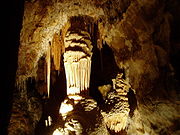

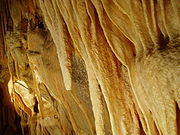
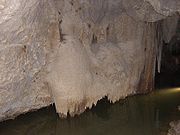
Caving
Caving—also occasionally known as spelunking in the United States and potholing in the United Kingdom—is the recreational pastime of exploring wild cave systems...
, especially those areas along the underground river system; but, there are ten caves at Jenolan that have been developed for regular tourism.
- Lucas Cave: Discovered in 1860 and the most popular among visitors. The Lucas Cave (named after local politician John LucasJohn Lucas (Australian politician)John Lucas was an Australian politician and a member of the New South Wales Legislative Assembly from 1860 to 1869 and 1871 to 1880 and the New South Wales Legislative Council from 1880 until his death. He was a member for Canterbury from 1860 to 1864 and from 1871 to 1880 and a member for Hartley...
who pushed to have the caves preserved in the 1860s) features a number of large chambers including the Cathedral, over 50 metres high, and the vast Exhibition Chamber which contains the Broken Column formation. The Cathedral is also used for wedding ceremonies and recitals. The Cathedral Chamber, the highest Chamber within the Lucas Cave, is the venue for monthly cello and Gypsy music concerts, as well as other special concerts, including by local band Didgeridoo Dingo.
- River Cave: Discovered in 1903, the River Cave is the most extensive show cave at Jenolan and includes some of its most famous features, including the Minaret, the Grand Column and the Queen's Canopy, as well as part of the River Styx. Until 1923 when a concrete bridge was built, a section of river in this cave was crossed by a small boat.
- Chifley Cave: Discovered in 1880 and with electric lighting installed almost immediately, the Chifley Cave was known as the Left Imperial Cave until 1952, when it was renamed in honour of the then recently-deceased former Prime Minister Ben ChifleyBen ChifleyJoseph Benedict Chifley , Australian politician, was the 16th Prime Minister of Australia. He took over the Australian Labor Party leadership and Prime Ministership after the death of John Curtin in 1945, and went on to retain government at the 1946 election, before being defeated at the 1949...
, who grew up in nearby BathurstBathurst, New South Wales-CBD and suburbs:Bathurst's CBD is located on William, George, Howick, Russell, and Durham Streets. The CBD is approximately 25 hectares and surrounds two city blocks. Within this block layout is banking, government services, shopping centres, retail shops, a park* and monuments...
. Two of the cave's chambers are decorated with coloured lights. The Chifley Cave was the first cave in the world to be lit by electric light, having been illuminated this way in 1880.
- Imperial Cave: Discovered in 1879, this is the easiest cave to visit for tourists. The Imperial contains some of the best fossil deposits and several Tasmanian DevilTasmanian DevilThe Tasmanian devil is a carnivorous marsupial of the family Dasyuridae, now found in the wild only on the Australian island state of Tasmania. The size of a small dog, it became the largest carnivorous marsupial in the world following the extinction of the thylacine in 1936...
bones. Note that whilst fossils may not be clearly evident to the casual visitor, in fact the bedrock in which the caves are formed is richly endowed with marine fossils. A side-branch known as the Diamond Cave is occasionally shown in combination with the Imperial Cave.
- Orient Cave: Discovered in 1903, the Orient Cave was not opened to public inspection until 1917, to allow for the installation of electric lighting and paths. This cave contains some of the grandest formations in the complex and was steam cleaned to preserve them in 1968. Until 1954, this cave, along with the Temple of Baal and Ribbon Caves, were only accessible through the River Cave. That year, the Binoomea Cut was constructed near Caves House to facilitate easier access to these caves. A new high-tech LEDLEdLEd is a TeX/LaTeX editing software working under Microsoft Windows. It is a freeware product....
-based lighting system has recently been installed, showing the cave to great effect.
- Ribbon Cave: Discovered at the same time as the Orient Cave, it was originally part of that tour but is now visited separately. The Ribbon Cave is only 60 metres long but is very richly decorated.
- Pool of Cerberus Cave: Discovered in 1903, this cave is a lower arm of the River Cave. The major formations here are the Bath of Venus and part of the underground river system that forms the Pool of Cerberus itself. Also includes rare aragoniteAragoniteAragonite is a carbonate mineral, one of the two common, naturally occurring, crystal forms of calcium carbonate, CaCO3...
formations. Pool of Cerberus Cave is also known for the Aboriginal skeleton found there.
- Jubilee Cave: Discovered in 1893, the Jubilee Cave is the longest show cave at Jenolan. It takes the longest to see because it is fairly remote from the other caves but offers formations of stunning beauty at close quarters. Of the caves shown at Jenolan to the public it is the least visited due to the length of the tour and the small tour groups that can be taken there.
- Temple of BaalBaalBaʿal is a Northwest Semitic title and honorific meaning "master" or "lord" that is used for various gods who were patrons of cities in the Levant and Asia Minor, cognate to Akkadian Bēlu...
Cave: Discovered in 1904, the Temple of Baal Cave consists of only two chambers, one of which is dominated by the huge 9-metre shawl formation called the Angel's Wing. The cave is also famous for a high incidence of the peculiar formations known as HelictiteHelictiteA helictite is a speleothem found in limestone caves that changes its axis from the vertical at one or more stages during its growth. They have a curving or angular form that looks as if they were grown in zero gravity...
s. The name derives from the biblical story of BaalBaalBaʿal is a Northwest Semitic title and honorific meaning "master" or "lord" that is used for various gods who were patrons of cities in the Levant and Asia Minor, cognate to Akkadian Bēlu...
, and the feature names in the cave largely relate to that story. Recent development work has upgraded the lighting and added an audio accompaniment to the cave experience.
- Nettle Cave: The Nettle Cave lies between the Grand Arch and the Devils Coach House. The cave takes its name from the nettles which grow near its entrance (note that raised walkways protect visitors from their stings); an upper part of this cave can be seen from inside the Devil's Coach House. Originally shown as a guided tour, the cave was closed to the public in 1932. In December 2006, this cave was re-opened to the public as a self-guided audio tour, combined with the adjoining Devil's Coach House. The Nettle Cave hosts "Crayfish backs", stromatoliteStromatoliteStromatolites or stromatoliths are layered accretionary structures formed in shallow water by the trapping, binding and cementation of sedimentary grains by biofilms of microorganisms, especially cyanobacteria ....
s shaped by cyanobacteria, light and wind. They are estimated to be at least 20,000 years old.
The road from Sydney passes through the Arch and six of the cave tours leave from assembly points within it. Adjacent to the Grand Arch is the Devil's Coach House, a vast open-ended chamber that forms part of the many nature walks in the area. High above both of these is Carlotta Arch, a free-standing arch that is all that remains of a higher cavern system long since eroded and collapsed. Along with these areas, there are several other caves in the area, some of which are available for special tours.
- Elder Cave: Named from the Elder tree, visitors would climb down to enter the doline (sinkhole). Discovered in 1848, the Elder Cave was the first of the caves at Jenolan to be found and opened to tourists. It was later considered too difficult to develop adequately and tours eventually ceased; however in the late 1990s the Elder Cave was re-opened for adventure caving, and is sold as the Plughole Tour. It is not as well decorated as the regular show caves, but does feature signatures left by early visitors and includes a short section of the Imperial Cave.
- Aladdin Cave: The Aladdin Cave was first explored in the hope of developing a shorter path to the Jubilee Cave. It boasts an abundance of decorations not dissimilar to the Jubilee.
- Jersey Cave: An extension of the Elder Cave. One of the features is a fossilised thylacineThylacineThe thylacine or ,also ;binomial name: Thylacinus cynocephalus, Greek for "dog-headed pouched one") was the largest known carnivorous marsupial of modern times. It is commonly known as the Tasmanian tiger or the Tasmanian wolf...
skeleton.
- Arch Cave: This cave lies above Nettle Cave and part of it can be seen from the Devils Coach House. The entrance to this cave is at the base of Carlotta Arch (hence the name) and the stairs and locked gate can still be reached although the Arch Cave.
External links
- Jenolan Caves Reserve Trust (official site)
- Jenolan Caves Historical & Preservation Society
- Jenolan Caves Resort
- Concerts at Jenolan Caves
- Sydney Speleological Society (SSS) is a Sydney based caving group that runs many trips to Jenolan Caves each year
- Sydney University Speleological Society (SUSS) is a Sydney based speleological society that carries out work at Jenolan Caves

